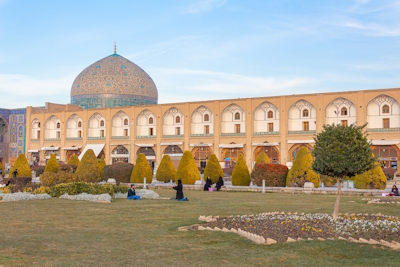Meidan Emam, Esfahan

Meidan Emam, Esfahan is one of the largest city squares in the world.
It was used in Persian socio-cultural life (for parades, celebrations and public executions) during the Safavid era. The square is surrounded by a homogenous ensemble of important historical buildings that were built over a short time span, such as the Shah Mosque, Ali Qapu Palace, Sheikh Lotf Allah Mosque and the Isfahan Grand Bazaar.
Community Perspective: “The darling of the Iranian tourism industry”. The best views of the square overall are to be had from the balcony of the Ali Qapu Palace, while the Emam or Shah Mosque is the square’s most striking component and the Sheik Lotfallah Mosque has a beautiful interior.


Map of Meidan Emam, Esfahan
Community Reviews
Carlo Sarion
Philippines/New Zealand - 10-Jan-20 -

I thought of reviewing an Iranian UNESCO World Heritage Site in light of Trump’s recent threat to the country’s cultural sites. Sheer insanity I thought, but thankfully, the Pentagon just completely ignored him as blasting cultural heritage sites constitutes a war crime. Date of Visit: December 2016.
Esfahan was the second city I visited during my backpacking trip to the country 3 years ago, and I truly enjoyed it. My first day in this city was spent in this square and the adjacent grand bazaar, taking heaps of photos and observing locals and tourists stroll, eat, shop, play and socialise. Meidan Emam is bounded in all sides by a 2-storey arcade, interrupted in the four cardinal directions by the following beautiful monuments and the Qeysarie gate of Esfahan’s grand bazaar:
- Ali Qapu Palace – as mentioned by Alexander, the view of the square from its balcony is stunning. From a casual traveler, I appreciate its beautiful ornamentation, design and architecture.
- Masjed-e Shah – the site’s UNESCO page mentions that it “remains the most celebrated example of the colorful architecture, which reached its high point in Iran under the Safavid dynasty”. At the time of my visit, scaffolding could be seen surrounding one side of the mosque’s dome. For some reason I could not recollect, it deterred me from going inside the mosque. Stupid me, I should’ve at least tried.
- Sheik Lotfallah Mosque - in terms of its interior, it is THE most beautiful mosque I have ever seen. This is the first monument I visited in the morning, which gave me an opportunity to have the entire place to myself and catch the sun rays penetrate the carved windows and lit the entire place to a beautiful golden hue! It was an astonishing sight!
I visited the above monuments in the morning and went straight to the bazaar to eat lunch. I dodged my way through as the bazaar was crowded with locals haggling and delivering goods (mostly carpets and spices) to various stalls.
I'd argue that the OUV of this site is best reflected by how this public square serves as an integral part of the daily lives of the people living in and around Esfahan, from the Safavid era to the present. Yes, it deserves inscription just by its sheer size (it is one of the world's largest public urban squares in the world) and beautiful architecture, but its function as a living heritage solidifies its status as a World Heritage site. Shah Abbas I must be proud of his legacy.
Alexander Parsons

The fact that the Meidan Emam was inscribed so early in the life of World Heritage is hardly a surprise; this square is the darling of the Iranian tourism industry, and rightly so. An interesting point to consider is this timing of the submission and acceptance of this site to the World Heritage List; the 1979 World Heritage Convention occurred in May, only a few months after the Islamic Revolution. The reference in the ICOMOS evaluation of 1979, and the other 1979 documents available on the UNESCO website, makes reference to the ‘Meidan-e Shah’, and the ‘Shah Mosque’, without any mention of the renaming of these components by the new regime. I guess the new Islamic Republic valued the prestige of the nomination enough to still accept it, though evidently with a name change, as the 1988 report makes no mention of the deposed shah. I am unsure of the precise nature of this process of naming; probably an unreported element of the 1979 convention?
The square, apart from the open space itself, has three main components. The obvious first stop is the Ali Qapu Palace, renowned more for its view of the square than for its own sake. This is unsurprising; while the palace has some nice ornamentation, especially on the top floor, the view is the real star here.
The Sheikh Lotfollah Mosque , directly opposite the palace, is unusual in that it has no courtyard or minaret, and comprises simply of a corridor and prayer room beneath the dome. This is a very impressive room, supposedly designed as a private chamber for royal concubines, but was completely crowded when I was there after lunch time. This was quite a detraction from the atmosphere. Given the popularity of Isfahan, arriving at opening time to a particularly desired attraction seems to the most sensible approach
The Emam Mosque, still often called the Shah Mosque, is the most striking component of the square, with its large façade and towering dome. I arrived at opening time to have it to myself. Within 15 minutes, however, 6 separate tour groups were competing for space. Unlike the Masjid-e Jame, this was a significant concern, as immense restoration works are currently underway. Overhearing an English-speaking guide, retiling work started a week prior to my visit (10 April 2016). The result of this was the covering of about 90% of the central courtyard of the mosque with a low tarpaulin ceiling, with about 20% of that remaining space being covered during my presence by ongoing work. This meant that all visitors were crowded beneath this section, trying to get a view of the dome. Within a couple of days, I expect this to be completely covered, which I imagine would severely impact the enjoyability of the site. By the scale of the tile restoration, I assume covering will exist for quite some time.
The square itself is worth seeing at all times of the day, with the Palace particularly impressive while illuminated after dark.
Community Rating
- : Ivan Rucek Juropa Merveil BH Stanislaw Warwas Alexandrcfif Fmaiolo@yahoo.com Ferhatdonmez Javier Tarquinio_Superbo Alexander Parsons Juha Sjoeblom MoPython Aspasia
- : Ammon Watkins Wojciech Fedoruk Solivagant George Gdanski Hanming Joyce van Soest Krijn Kevin247 Naim Y
- : Janis Richardleesa Michael anak Kenyalang Philipp Leu Dimitrios Polychronopoulos Jean Lecaillon Carlo Sarion Ssong.x Wieland Martina Rúčková Rodinia Tony H.
- : Adrian Turtschi Palimpsesto Chalamphol Therakul Bernard Joseph Esposo Guerrero GerhardM
- : Alexander Lehmann Szucs Tamas Alexander Barabanov Zizmondka Dorejd Xiquinho Silva Jon Opol
- : Zoë Sheng
Site Info
Site History
1979 Inscribed
Site Links
Unesco Website
Official Website
In the News
Connections
The site has 25 connections
Art and Architecture
Constructions
Damaged
History
Human Activity
Individual People
Religion and Belief
Timeline
Trivia
Visiting conditions
WHS Hotspots
WHS Names
WHS on Other Lists
World Heritage Process
Visitors
164 Community Members have visited.
The Plaque
No plaque has been identified yet for this site.